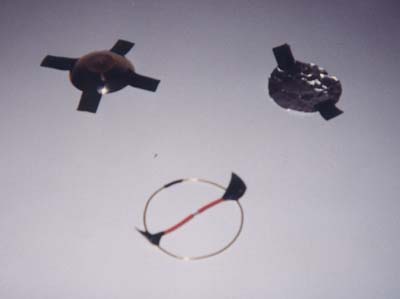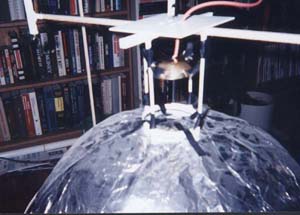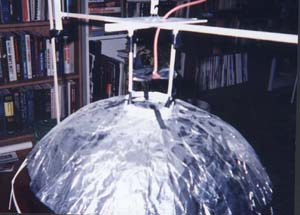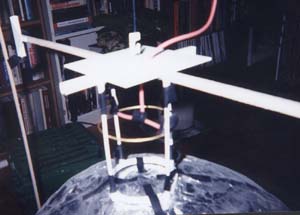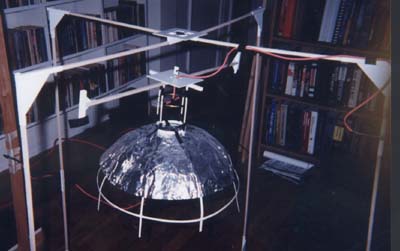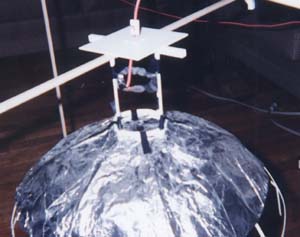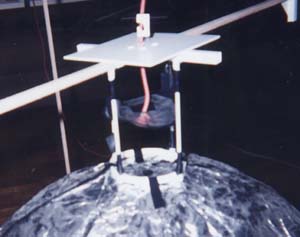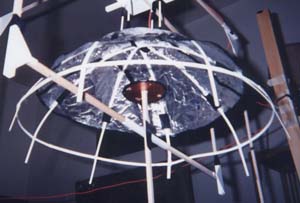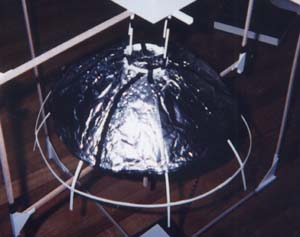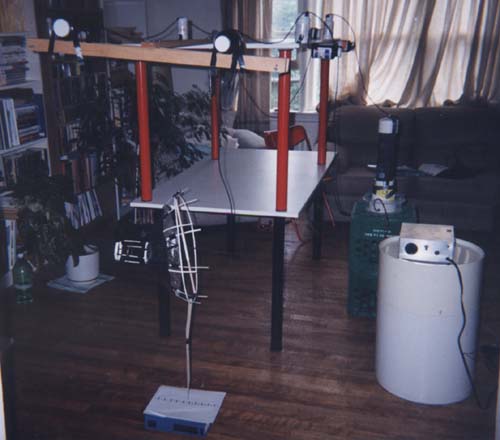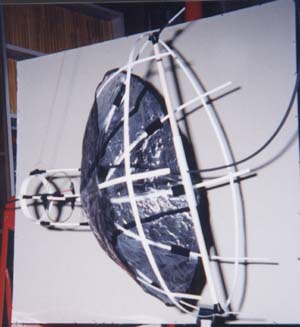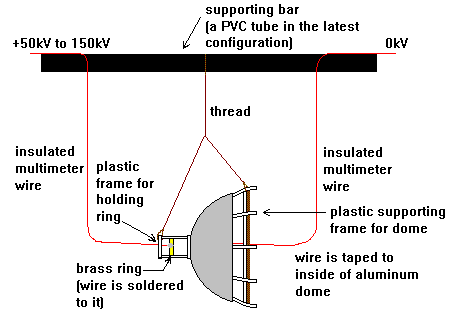These experiments were originally prompted by two things. The first were experiments by J. L. Naudin wherein he put the small electrode above the convex half of the dome electrode. The second was an email from someone (who may or may not wish to be named) who pointed out that false results could be obtained from using a digital scale. Specifically that the scale could show the device as getting heavier if it is influenced by the electric field, depending on the type of scale of course. The pendulum was to test if my scale was being affected. It turns out that it sometimes may be, but is most often not affected.
May 9/99 - Small electrode on top of convex part of dome
I tested with the following 3 electrodes on the convex part of the 1" dome: clockwise from top, left - 3" brass bowl, 3" aluminum foil disk, 3" brass ring
|
|
|
|
|
From these initial experiments, I concluded wrongly, that with the small electrode on the convex side of the dome, the device always moved in the direction of the positive and with the small electrode on the concave side of the dome, the device always moved in the direction of the dome. I concluded this because of a few tests with the brass ring where the brass ring was negative (grounded) and the dome was positive with respect to ground. In that one case the device gained weight (moved downwards). All other tests were done with the polarity reversed and all got lighter (moved upwards).
It wasn't until more exhaustive tests on May 15th, that I realized that this wasn't always the case.
May 15/99 - May 9th's conculsion wrong
Because of some email with J. L. Naudin, I tried again with the small electrode on the convex side of the 15" dome. This time I tried both polarities with the 3" aluminum foil disk. In both cases, it got lighter (moved upwards). This was different than with the brass ring wherein it always moved in the direction of the positive. I gave up, puzzled.
May 16/99 - Disk to ring
So to figure out what was happening, I decided to take a 3" aluminum foil disk and gradually convert it to a ring by cutting a hole in the middle and repeating the experiment, but with a larger hole each time. Eventually the disk should become just like the brass ring and I should see a reversal in direction of movement.
That didn't happen. Instead, no matter the size of the hole, the device always got lighter (moved upwards).
|
My new guess was that it wasn't the fact that I was using a ring, but that the ring was made of a solid wire which wasn't ionizing the air very much (i.e. it had no pointy edges). Instead, it retained it's charge - it didn't leak much.
May 16/99 continued - Tests with "less leaky" devices
So I next decided to do tests with leaky electrodes and less leaky electrodes to test my guess.
A number of small electrodes were tested as well as two different domes. One dome was simply aluminum foil (actually three pieces glued together) shaped as a dome. The other dome was the same as the first, but with all edges taped with black electrical tape so as to minimize leaking of ions to the air. I call the first dome, the Leaky 15" Dome and the second dome, the Less Leaky 15" Dome. Likewise, some of the small electrodes have two version, one with edges exposed (Leaky) and one with edges taped (Less Leaky). I'm not sure if the 3" brass ring should be classified as a Less Leaky electrode or in a class of its own.
|
|
|
Rather than putting the results here, I've summarized all results into a table below along with results using a pendulum.
May 19, 22, 29/99 - Device Hanging as a Pendulum
I received an email from someone who warned me that on some scales, the electric field could interfere some types of scales, making a device always look like it is getting heavier. As a result, I decided to parallel my scale measurements with pendulum measurements.
I found that in most cases, the scale and the pendulum agreed. In cases where the scale showed the direction of movement as downward, they either gave opposite results or the pendulum showed no movement at all. In the latter case, where the pendulum showed no movement, that is not necessarily an indication that the scale was wrong since a downward movement on the scale means a movement in the direction of the concave side of th 15" dome. At no time, did the pendulum move in that direction.
|
|
|
Table of results for May 9 to 29, 99
The following table summarizes all results of both scale and pendulum from May 9th to May 29th. Note that qualitative results are not given since too many variables vary over the period of experimentation. The only consistency is direction of movement.
Legend for the table:
- L. - Leaky
- LL. - Less Leaky
- LD - In the Dome column, this means 'Leaky 15" Dome'
- LLD - In the Dome column, this means 'Less Leaky 15" Dome'
- N - No visible movement
- * - This one showed strong rotation about its axis
- x - Direction of movement with scale is opposite than pendulum
The arrows indicate direction of movement. The small diagram of
a dome at the top of each column indicates the configuration for
that column. For example,  , is
the dome oriented vertically, i.e. on the scale, with the small
electrode on the convex side of the dome, positive on the small
electrode, negative on the dome. Another example,
, is
the dome oriented vertically, i.e. on the scale, with the small
electrode on the convex side of the dome, positive on the small
electrode, negative on the dome. Another example,
 , is the dome oriented horizontally,
i.e. as a pendulum, with the small electrode on the concave side
of the dome, positive on the small electrode, negative on the dome.
, is the dome oriented horizontally,
i.e. as a pendulum, with the small electrode on the concave side
of the dome, positive on the small electrode, negative on the dome.
| Device | Dome | Scale |
Pendulum |
Scale |
Pendulum |
Scale |
Pendulum |
Scale |
Pendulum |
|---|---|---|---|---|---|---|---|---|---|
| L. 3" Copper disk | LD LLD |
  |
  |
  |
  |
 |
 |
 |
 |
| LL. 3" Copper disk | LD LLD |
 x x |
 x xN |
  |
N N |
||||
| L. 3" Alumin. disk | LD LLD |
 |
N |
 |
 |
 |
 |
 |
 |
| LL. 3" Alumin. disk | LD LLD |
N |
N* N |
  |
N N |
||||
| 3" Brass ring | LD LLD |
 |
 |
 |
 |
  |
  |
 x x x x |
 x x x x |
Table of results for May 9 to 29, 99
The tests with the Brass ring showed some interesting results worth pursuing. In some cases when the voltage would first be turned on, there be a brief hiss. Then there would be silence except for a high frequency sound. During this silent period, the device would show strong movement. Then when the voltage reached some level, the device would hiss and possibly arc and the strength would diminish, dropping back to a previous position. As voltage was turned up further, it would not recover.
There are two ways I can see to interpret this. One way is that there are two types of propulsion being exhibited, possibly the Biefeld-Brown effect and ion wind. The Biefeld-Brown would be the silent part, the ion wind would be the hissing part (i.e. discharging to the air). Keep in mind that the Biefeld-Brown effect is possibly a result of electric fields and discharging to the air would be accompanied by weakened electric field. The other way to interpret this is that there is only the Biefeld-Brown efect, and that the hissing is when the electric field is weakened and so the effect is less, any ion wind being negligable.
Arcing making tiny holes in domes
One factor ocurred that may invalidate some of the results above. After having done all experiments, I looked at the surface of the domes against a bright blue sky. The domes, especially the Less Leaky 15" Dome, were full of very tiny pinhole size holes (possibly around 50). This, I guess, was due to the arcing that often ocurred. Since there were more on the newer Less Leaky Dome than on the older Leaky Dome, my guess is that they were probably due to tests with the Less Leaky small electrodes. These Less Leaky electrodes would build up more charge before arcing and would therefore arc more strongly.
The reason that this may invalidate some results is that a hole-riddled dome would leak. Since more and more holes appeared over time, the latter tests would be more affected by them. Unfortunately, with the way the data was gathered, I do not know which tests those were.
Conclusion
I did not manage to convince myself if some configurations in fact do always move towards the positive, since my scale either gives different results in these cases than the pendulum or the pendulum gives no results. Perhaps it is that the scale is giving false readings or the pendulum is not sensitive enough.
It would be interesting to try and make a device that leaks as little as possible and test some more.

